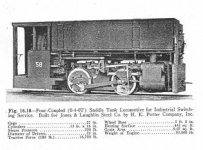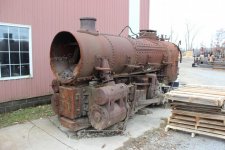Rick Rowlands
Titanium
- Joined
- Jan 8, 2005
- Location
- Youngstown, Ohio
For the past month or so I've been working on a new project out here at Youngstown Steel Heritage. I want to add a bit of steel industry rail operations to the museum, so have decided to construct a narrow gauge ingot mold railway for demonstrating the teeming, handling and stripping of ingot molds in a steel mill.

In the steel industry, before the advent of continuous casters, steel assumed its first solid form as ingots. Ingots were made by pouring steel into ingot molds, heavy iron castings that contained the steel as it solidified. The molds were filled (teemed) on very heavy flatcars known as ingot buggies on the teeming platforms in the open hearth shop then moved to a yard where the ingots solidified. From there they were moved to the stripper building where the molds were pulled off of the ingots and placed on empty buggies on an adjacent track. The ingots in the cars were then moved to the soaking pits and the molds, after receiving a lime wash, went back to the open hearth for teeming again.
I have enough room at the museum to replicate the teeming and stripping processes. In front of our building I am planning on erecting half of a teeming ladle that we saved from Duquesne Works, and by running a spur track under it I'll be able to spot buggies for simulated teeming. From there we go around back of the building into a new addition where the Morgan crane would do the ingot stripping.

The track gauge will be 23", and the motive power will consist of Jones & Laughlin Steel Co. No. 58, an 0-4-0T Porter that will be coming to the museum very soon. We will most likely build our own ingot buggies, and for ingots we will obtain them from the last ingot mold maker in the US, which happens to be located five miles from the museum.

The track plan shows the extent of the railway. The red line is track that we have built over the past month, and the blue is track to be built. The initial portion is 100 lb. rail, going down to 85 lb. ASCE for the rest. The curve is 40 ft. radius and it is laid on steel ties to hold everything together.
When completed, the ingot mold railway will join the Tod Engine, the Hot Metal Train and the Rotary Converter as the main exhibits at the Youngstown Steel Heritage Museum. The museum holds two open houses per year, in June and September.

In the steel industry, before the advent of continuous casters, steel assumed its first solid form as ingots. Ingots were made by pouring steel into ingot molds, heavy iron castings that contained the steel as it solidified. The molds were filled (teemed) on very heavy flatcars known as ingot buggies on the teeming platforms in the open hearth shop then moved to a yard where the ingots solidified. From there they were moved to the stripper building where the molds were pulled off of the ingots and placed on empty buggies on an adjacent track. The ingots in the cars were then moved to the soaking pits and the molds, after receiving a lime wash, went back to the open hearth for teeming again.
I have enough room at the museum to replicate the teeming and stripping processes. In front of our building I am planning on erecting half of a teeming ladle that we saved from Duquesne Works, and by running a spur track under it I'll be able to spot buggies for simulated teeming. From there we go around back of the building into a new addition where the Morgan crane would do the ingot stripping.

The track gauge will be 23", and the motive power will consist of Jones & Laughlin Steel Co. No. 58, an 0-4-0T Porter that will be coming to the museum very soon. We will most likely build our own ingot buggies, and for ingots we will obtain them from the last ingot mold maker in the US, which happens to be located five miles from the museum.

The track plan shows the extent of the railway. The red line is track that we have built over the past month, and the blue is track to be built. The initial portion is 100 lb. rail, going down to 85 lb. ASCE for the rest. The curve is 40 ft. radius and it is laid on steel ties to hold everything together.
When completed, the ingot mold railway will join the Tod Engine, the Hot Metal Train and the Rotary Converter as the main exhibits at the Youngstown Steel Heritage Museum. The museum holds two open houses per year, in June and September.




 Looks like quite a project.
Looks like quite a project.
